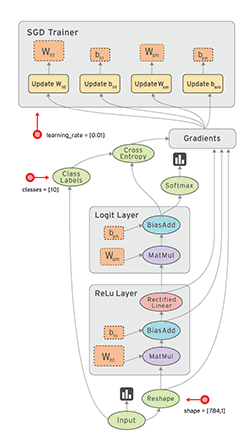
About TensorFlow
TensorFlow™ is an open source software library for numerical computation using data flow graphs. Nodes in the graph represent mathematical operations, while the graph edges represent the multidimensional data arrays (tensors) communicated between them. The flexible architecture allows you to deploy computation to one or more CPUs or GPUs in a desktop, server, or mobile device with a single API. TensorFlow was originally developed by researchers and engineers working on the Google Brain Team within Google's Machine Intelligence research organization for the purposes of conducting machine learning and deep neural networks research, but the system is general enough to be applicable in a wide variety of other domains as well
What is a Data Flow Graph?
Data flow graphs describe mathematical computation with a directed graph of nodes & edges. Nodes typically implement mathematical operations, but can also represent endpoints to feed in data, push out results, or read/write persistent variables. Edges describe the input/output relationships between nodes. These data edges carry dynamically-sized multidimensional data arrays, or tensors. The flow of tensors through the graph is where TensorFlow gets its name. Nodes are assigned to computational devices and execute asynchronously and in parallel once all the tensors on their incoming edges becomes available.

TensorFlow Features
Deep Flexibility
TensorFlow isn't a rigid neural networks library. If you can express your computation as a data flow graph, you can use TensorFlow. You construct the graph, and you write the inner loop that drives computation. We provide helpful tools to assemble subgraphs common in neural networks, but users can write their own higher-level libraries on top of TensorFlow. Defining handy new compositions of operators is as easy as writing a Python function and costs you nothing in performance. And if you don't see the low-level data operator you need, write a bit of C++ to add a new one.
True Portability
TensorFlow runs on CPUs or GPUs, and on desktop, server, or mobile computing platforms. Want to play around with a machine learning idea on your laptop without need of any special hardware? TensorFlow has you covered. Ready to scale-up and train that model faster on GPUs with no code changes? TensorFlow has you covered. Want to deploy that trained model on mobile as part of your product? TensorFlow has you covered. Changed your mind and want to run the model as a service in the cloud? Containerize with Docker and TensorFlow just works.
Connect Research and Production
Gone are the days when moving a machine learning idea from research to product require a major rewrite. At Google, research scientists experiment with new algorithms in TensorFlow, and product teams use TensorFlow to train and serve models live to real customers. Using TensorFlow allows industrial researchers to push ideas to products faster, and allows academic researchers to share code more directly and with greater scientific reproducibility.
Auto-Differentiation
Gradient based machine learning algorithms will benefit from TensorFlow's automatic differentiation capabilities. As a TensorFlow user, you define the computational architecture of your predictive model, combine that with your objective function, and just add data -- TensorFlow handles computing the derivatives for you. Computing the derivative of some values w.r.t. other values in the model just extends your graph, so you can always see exactly what's going on.
Language Options
TensorFlow comes with an easy to use Python interface and a no-nonsense C++ interface to build and execute your computational graphs. Write stand-alone TensorFlow Python or C++ programs, or try things out in an interactive TensorFlow iPython notebook where you can keep notes, code, and visualizations logically grouped. This is just the start though -- we’re hoping to entice you to contribute interfaces to your favorite language -- be it Lua, JavaScript, or R.
Maximize Performance
Want to use every ounce of muscle in that workstation with 32 CPU cores and 4 GPU cards? With first-class support for threads, queues, and asynchronous computation, TensorFlow allows you to make the most of your available hardware. Freely assign compute elements of your TensorFlow graph to different devices, and let TensorFlow handle the copies.
Companies Using TensorFlow










